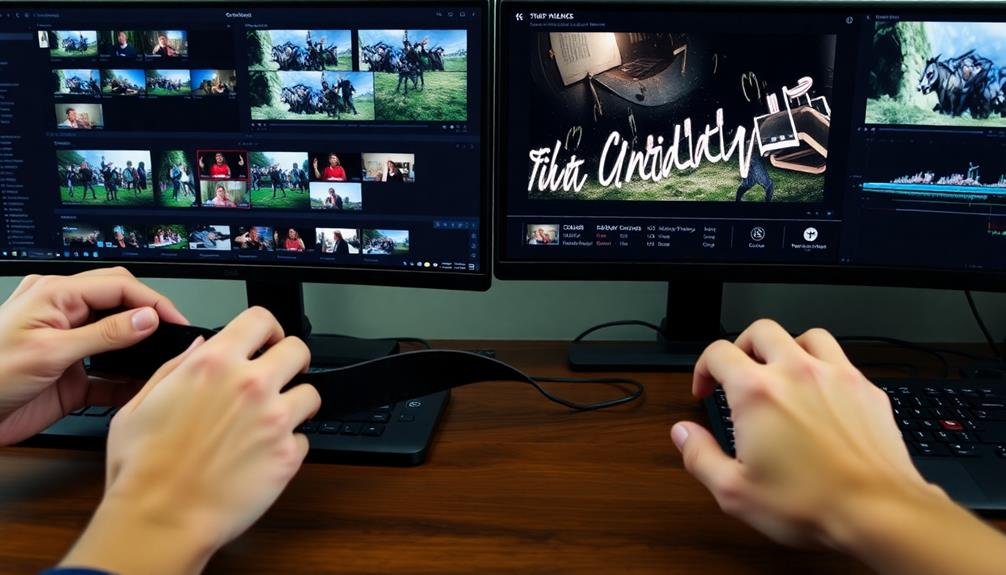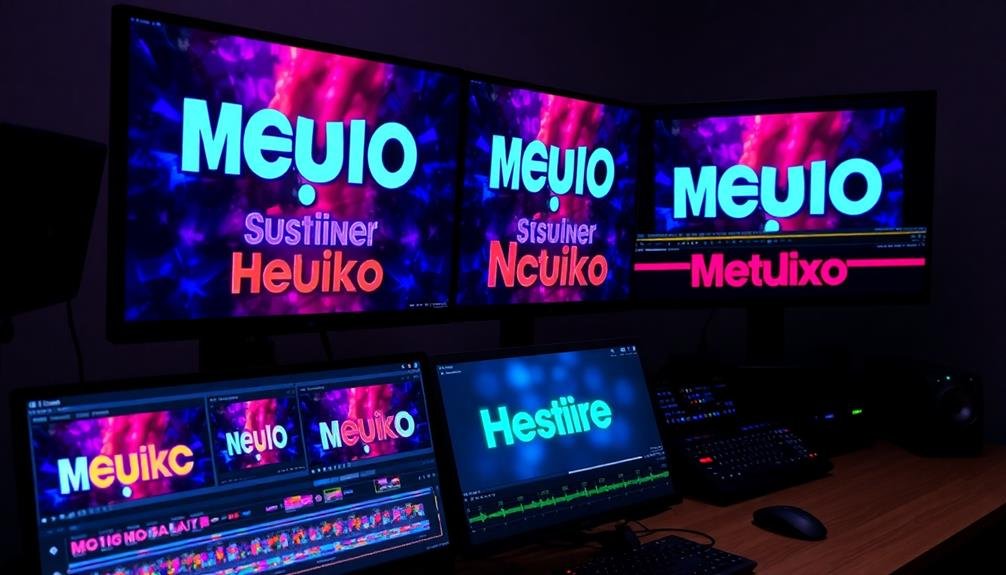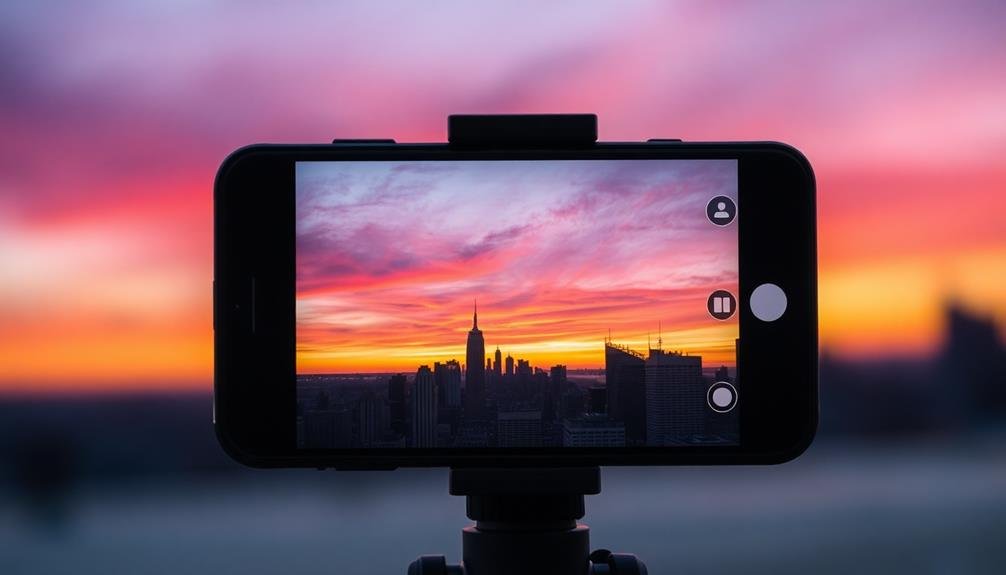To elevate your social media videos, focus on these three pro editing tips: First, master quick cuts to maintain viewer interest by rapidly shifting between impactful shots. Second, optimize for silent viewing by adding captions and using visual storytelling techniques, as many users scroll with sound off. Third, incorporate eye-catching text overlays with easy-to-read fonts and contrasting colors to grab attention and convey key messages. By implementing these strategies, you'll create more engaging content that stands out in crowded feeds. Each technique requires careful planning and execution, but the results can greatly boost your video's performance and reach. Discover how to apply these tips effectively in your next project.
Master Quick Cuts

Mastering quick cuts is essential for creating engaging social media videos. This technique involves rapidly shifting between shots to maintain viewer interest and convey information efficiently. To execute quick cuts effectively, you'll need to plan your shots carefully and gather plenty of footage.
Start by organizing your clips in your editing software's timeline. Trim each clip to its most impactful moments, removing any unnecessary content. As you arrange your shots, aim for a dynamic rhythm that matches the pace of your video's subject matter or background music.
When implementing quick cuts, consider these tips:
- Vary shot lengths to create visual interest
- Use J-cuts and L-cuts to smooth shifts between scenes
- Incorporate motion graphics or text overlays to enhance the flow
- Match action across cuts to maintain continuity
- Experiment with different transition styles, like swipes or fades
Optimize for Silent Viewing

Three key factors make optimizing for silent viewing essential in social media video editing. First, many users scroll through their feeds with the sound off. Second, autoplay features often default to mute. Third, some platforms don't enable sound unless the viewer actively turns it on.
To adapt to these conditions, you'll need to make your videos comprehensible without audio. Start by adding captions or subtitles to all spoken content. Use large, easy-to-read fonts and guarantee the text contrasts well with the background. Keep captions concise and well-timed with the visuals.
Incorporate visual storytelling techniques to convey your message. Use on-screen text, graphics, and animations to highlight key points. Show, don't tell, by using expressive body language and clear visual demonstrations.
Structure your video with a strong visual hierarchy. Use bold titles, eye-catching thumbnails, and visually striking opening scenes to grab attention. Employ visual cues like arrows, highlights, or zooms to guide the viewer's focus.
Use Eye-Catching Text Overlays

Text overlays are a powerful tool in your social media video editing arsenal. They grab attention, convey key messages, and enhance viewer engagement.
When using text overlays, choose fonts that are easy to read and align with your brand's aesthetic. Stick to one or two font styles throughout your video to maintain consistency.
Size matters when it comes to text overlays. Confirm your text is large enough to be read on small mobile screens, where most social media content is consumed. Use contrasting colors between your text and background to improve readability.
Animate your text to add visual interest, but keep movements subtle to avoid distracting from your main content. Strategically place text overlays to emphasize important points or provide context. Use them to highlight key statistics, quotes, or calls-to-action.
Don't overload your video with text; instead, use it sparingly for maximum impact. Consider using lower thirds to introduce speakers or locations without cluttering the main frame.
Experiment with different text styles, such as handwritten fonts or animated typography, to create a unique look that sets your videos apart. Always proofread your text overlays to avoid embarrassing typos that can undermine your credibility.
Frequently Asked Questions
What Video Editing Software Is Best for Social Media Content?
You'll find several great options for social media video editing. Popular choices include Adobe Premiere Pro, Final Cut Pro X, and DaVinci Resolve for professionals. For beginners, try user-friendly options like iMovie, Filmora, or OpenShot.
How Long Should Social Media Videos Be for Optimal Engagement?
You'll want to keep your social media videos short and sweet. For Instagram and TikTok, aim for 15-30 seconds. On Facebook and Twitter, 1-2 minutes works well. Longer content's better suited for YouTube, where 5-10 minutes is ideal.
What Aspect Ratios Work Best for Different Social Media Platforms?
You'll want to use different aspect ratios for each platform. Instagram prefers 1:1 (square) or 4:5 (vertical). Facebook works well with 16:9 (horizontal) or 1:1. TikTok and Instagram Stories favor 9:16 (vertical).
How Can I Improve Video Quality When Uploading to Social Media?
You can improve video quality on social media by using high resolution, optimizing bitrate, compressing files wisely, and choosing the right format. Don't forget to adjust lighting, stabilize footage, and use a good microphone for better audio.
What's the Ideal Frame Rate for Social Media Videos?
For most social media platforms, you'll want to aim for 30 frames per second (fps). It's a standard that balances smooth motion with file size. However, 24 fps can work for a more cinematic look.
In Summary
You've now got three powerful tools to elevate your social media videos. By mastering quick cuts, you'll keep viewers engaged. Optimizing for silent viewing guarantees your message reaches audiences in any setting. And eye-catching text overlays will make your content pop. Don't be afraid to experiment with these techniques. The more you practice, the better you'll become at creating scroll-stopping videos that captivate your audience and boost your social media success. Start implementing these tips today!





Leave a Reply